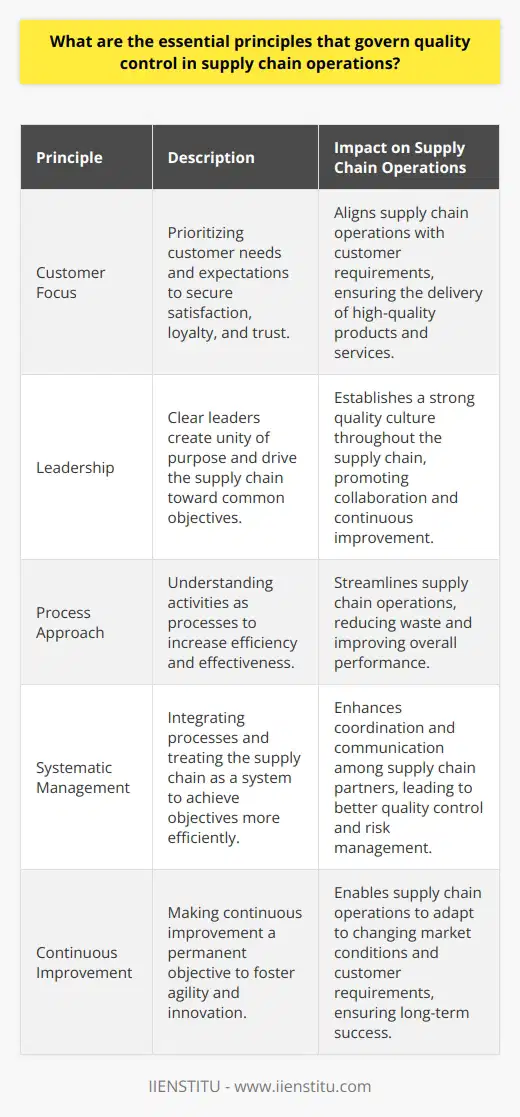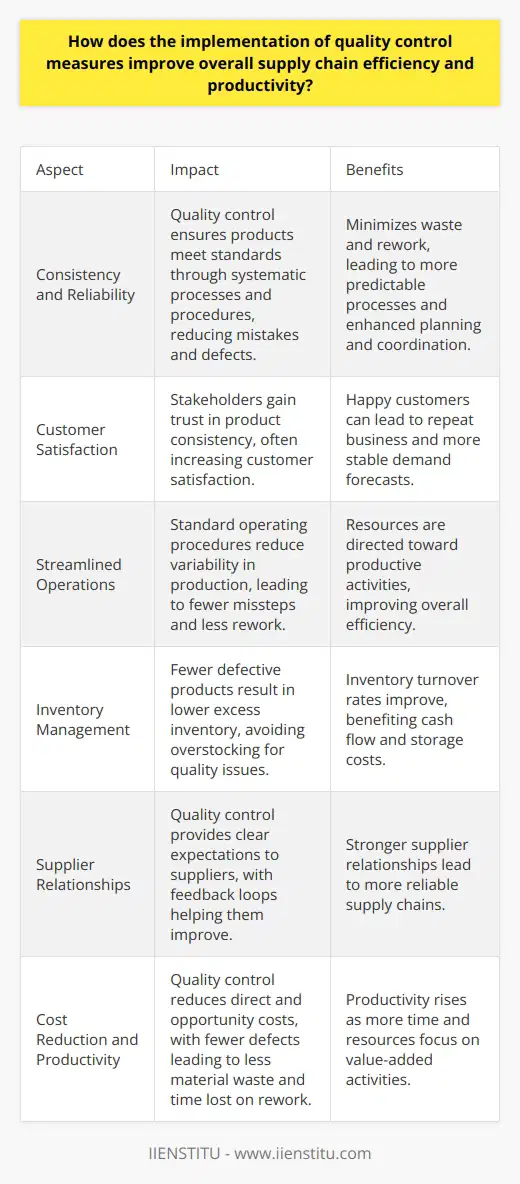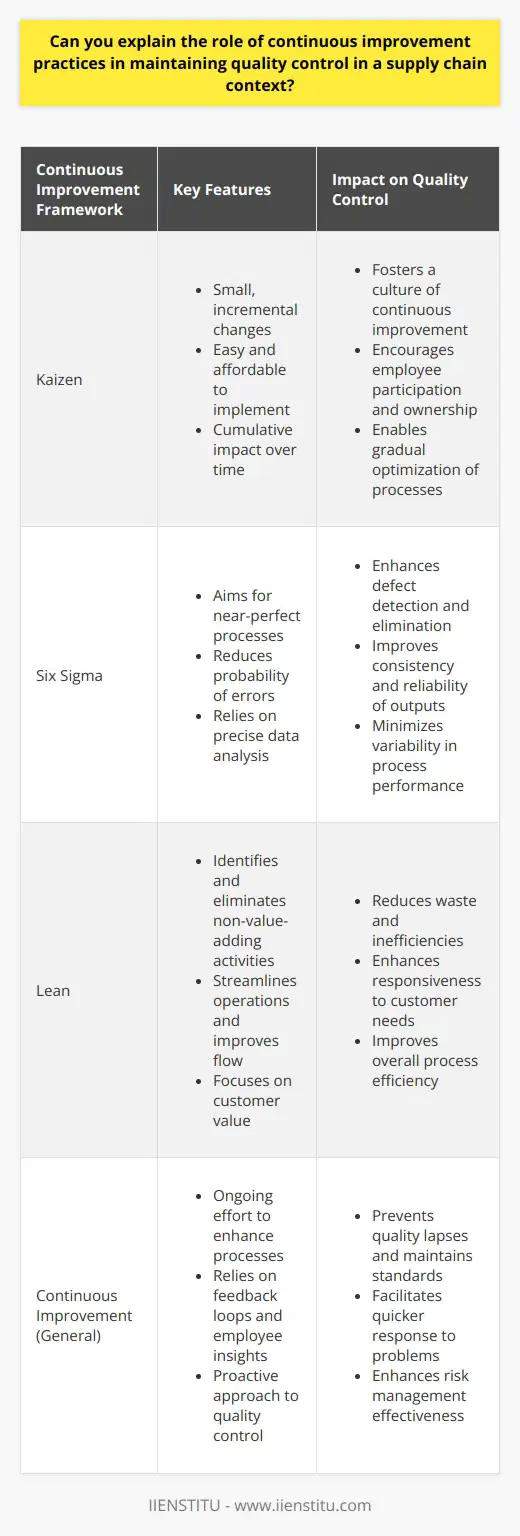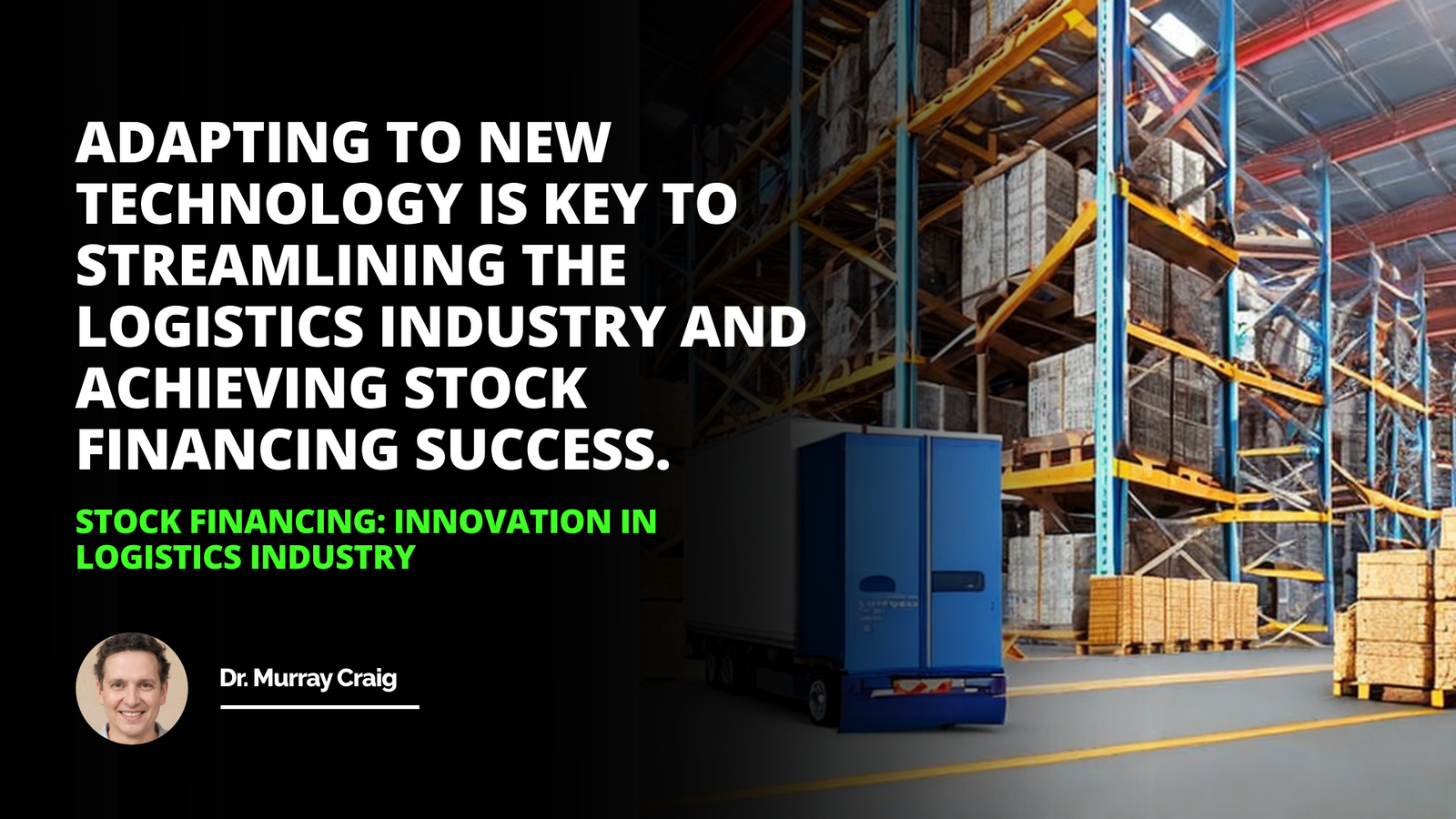
In today's competitive business landscape, quality control (QC) is not just a matter of maintaining standards—it's about sustaining the very foundation upon which successful companies are built. From consumer electronics to textiles, and from pharmaceuticals to automobiles, quality control is the backbone that ensures every product meets or exceeds customer expectations. As globalization continues to reshape industries, it becomes increasingly important for companies to understand how QC principles apply specifically to their supply chain operations.
This article dives deep into the principles of quality control in supply chain management, exploring its history, the processes involved, and how technology is transforming QC practices today. I'll also share personal experiences and insights into how quality control shapes the supply chain landscape, providing real-life examples to make the concepts more relatable.
Understanding the Basics of Quality Control
Quality control is not a new concept, but its importance has grown exponentially with the rise of global supply chains. It involves a systematic process of testing, monitoring, and verifying products at various stages of production to ensure that they meet predefined standards. For businesses, QC is critical not only to upholding brand reputation but also to ensuring customer satisfaction and reducing costs related to defects or recalls.
I remember, early in my career, working with a mid-sized manufacturing company that struggled with quality control issues. They had been receiving complaints about product defects, which affected their reputation. We quickly realized that they lacked consistent metrics for assessing product quality. It wasn't until they established clear standards and introduced regular inspections that they saw a drop in defective products—and the positive feedback from customers was a testament to this improvement.
The Distinction Between Quality Control and Quality Assurance
It's essential to understand the difference between quality control (QC) and quality assurance (QA)—two terms that are often used interchangeably.
Quality assurance is more proactive. It focuses on improving processes and systems to prevent defects from occurring in the first place. It is about creating an environment where quality is built into every step of the production process.
Quality control, on the other hand, is reactive. It focuses on identifying defects in the final product through inspections and testing.
Think of it this way: quality assurance is like putting up guardrails on a winding mountain road, while quality control is like the net that catches you if you still manage to veer off course. Both are necessary, but they serve different purposes in achieving the ultimate goal of consistent quality.
The Process of Quality Control in Supply Chains
The QC process typically follows a structured path involving several stages, each critical for ensuring quality standards are met.
Establishing Key Metrics
The foundation of any quality control effort is identifying the right metrics. Whether it's defect rates, turnaround times, or customer satisfaction scores, these metrics serve as benchmarks. Without them, it’s impossible to know if you're improving or falling short. For instance, a textile manufacturer may track metrics like fabric tensile strength, color fastness, and seam integrity to ensure quality standards are met throughout production.
Setting Standards
Once the metrics are defined, the next step is to set standards—benchmarks that a product must meet to be deemed acceptable. These standards can be influenced by regulatory requirements, customer expectations, or the company’s own quality goals. In some industries, like pharmaceuticals, these standards can be incredibly stringent, reflecting the high stakes of product quality.
I once worked with a pharmaceutical company that took its quality standards very seriously. Every pill that came off their production line had to meet precise specifications. Even a minor deviation in weight or composition would result in an entire batch being scrapped. Their diligence in maintaining these standards not only kept them compliant with regulations but also earned them a reputation as a trusted brand.
Monitoring and Testing
With standards in place, businesses must continually monitor and test products at various stages. This involves using a mix of manual inspections and automated systems. For instance, automated cameras can quickly detect irregularities in a production line, while manual inspections might catch more subtle defects that machines overlook.
Regular reviews and audits help keep these processes sharp, ensuring that standards are consistently met. Online courses and logistics certification programs can offer valuable insights into the latest practices and technologies in this area, helping professionals stay up-to-date.
Feedback and Continuous Improvement
Quality control is not a "set it and forget it" process. It requires continuous improvement, where feedback from monitoring results is used to adjust processes. This aligns with the principles of Lean and Six Sigma, methodologies that emphasize ongoing refinement to reduce waste and improve quality.
Tools and Techniques in Quality Control
Quality control relies on a variety of tools and techniques to maintain high standards. Some of the most effective methods include:
Statistical Process Control (SPC): A method that uses statistical techniques, such as control charts, to monitor and control production processes. It allows businesses to identify trends or variations before they lead to defects. A practical example could be an automotive manufacturer using SPC to ensure brake pad dimensions remain within acceptable limits throughout production.
Variance Analysis: This technique helps identify deviations from expected outcomes in a process. By analyzing these variances, companies can make targeted adjustments to bring the process back in line. It's especially useful in industries where small deviations can significantly affect product quality.
Failure Testing: Also known as stress testing, this involves pushing a product to its limits to understand its breaking points. This approach is commonly used in electronics manufacturing, where companies test the durability of smartphones by subjecting them to extreme conditions, like temperature variations and impact forces.
Visual Inspection: Despite advances in technology, there is still a place for the human eye in quality control. In industries like textiles or food production, skilled inspectors can detect subtle issues that automated systems might miss.
These methods provide companies with the tools they need to detect and address quality issues promptly, maintaining the reliability and integrity of their products.
The Role of Technology in Modern Quality Control
In recent years, technology has reshaped how businesses approach quality control, bringing unprecedented levels of accuracy and efficiency. The emergence of artificial intelligence (AI), machine learning, and automated systems has revolutionized QC, particularly in large-scale operations.
Automation for Consistency
Automation has enabled companies to maintain consistent quality standards across high-volume production lines. For example, automated vision systems can inspect thousands of items per minute, identifying defects that would be impossible for human inspectors to catch at such speed.
I remember visiting a factory that produced beverage bottles. They had automated scanners checking each bottle for micro-cracks that could lead to leaks. This setup allowed them to catch issues early, saving them from expensive recalls and ensuring their customers received a reliable product.
AI and Predictive Quality Control
AI systems go a step further by using predictive analytics to forecast potential defects before they occur. These systems learn from historical data and production trends, allowing companies to make proactive adjustments. For example, a food manufacturer might use AI to analyze temperature and humidity data from their production facilities to predict when machinery is likely to malfunction, thus avoiding product spoilage.
Blockchain for Supply Chain Transparency
Another promising technology in the realm of quality control is blockchain. By providing an immutable ledger of transactions and product journeys, blockchain can ensure traceability throughout the supply chain. This is especially valuable in industries like pharmaceuticals or luxury goods, where authenticity and origin are critical.
Challenges in Implementing Quality Control Across Supply Chains
Implementing robust quality control measures across global supply chains is no easy feat. Some of the key challenges include:
Variability of Suppliers: Sourcing raw materials from different suppliers can lead to inconsistency in product quality. Variations in materials, even if slight, can impact the final product’s performance.
Geographical Disparities: Factories in different regions might have varying levels of technical expertise, infrastructure, and adherence to quality standards. This makes it difficult to maintain a uniform level of quality across different production sites.
Cultural Differences: Different regions may have varied approaches to quality, influenced by local practices and cultural norms. Bridging these gaps requires effective communication and a shared understanding of quality standards.
The Future of Quality Control: Where Are We Headed?
As we look to the future, sustainability and eco-efficiency are emerging as critical aspects of quality control. Companies are not only focusing on the intrinsic quality of their products but also on how their production processes impact the environment. This shift reflects a broader trend towards corporate social responsibility (CSR).
Experts predict that technologies like Internet of Things (IoT) and smart sensors will play a more prominent role in QC, offering real-time insights into production processes. Additionally, the emphasis on green manufacturing means that companies will need to account for the environmental impact of their production methods as part of their overall quality strategy.
Conclusion
The principles of quality control in supply chain operations are not merely about adhering to standards; they encompass a commitment to excellence that directly influences a company's success and reputation. Whether through traditional methods like visual inspections or cutting-edge technologies like AI, maintaining high quality remains a dynamic and evolving challenge.
Reflecting on my own experiences, I’ve seen firsthand how a commitment to quality can transform a business. It's not just about meeting benchmarks; it's about building trust with your customers, delivering consistent value, and continuously improving to adapt to new challenges. As the global market becomes increasingly interconnected, this commitment to quality becomes even more crucial—not only for competing but for thriving.
References
Deming, W. Edwards. Out of the Crisis. MIT Press, 1986.
Juran, Joseph M. Juran on Quality by Design. Free Press, 1992.
Montgomery, Douglas C. Introduction to Statistical Quality Control. Wiley, 2020.
Tan, Keah Choon, et al. Supply Chain Management: A Global Perspective. Cengage Learning, 2019.
Frequently Asked Questions
What are the essential principles that govern quality control in supply chain operations?
Introduction to Supply Chain Quality Control
Supply chain operations ensure products meet certain standards. Quality control becomes crucial here. It upholds product integrity across the supply chain.
Core Principles of Quality Management
Customer Focus is primary. Always prioritize customer needs. Meeting expectations secures satisfaction, loyalty, and trust.
Leadership sets the direction. Clear leaders create unity of purpose. They drive the supply chain toward common objectives.
Process Approach is another key principle. Understand activities as processes. This approach increases efficiency and effectiveness.
Systematic Management integrates processes. Treat the supply chain as a system. Interrelated processes achieve objectives more efficiently.
Continuous Improvement should drive operations. Make it a permanent objective. This principle fosters agility and innovation.
Factual Approach to Decision Making matters much. Decisions must rely on data. Analyze and evaluate data to guide actions.
Relationship Management also proves essential. Maintain good relationships with suppliers. This enhances performance and creates value.
Implementing Quality Control in Supply Chain
Supply Chain Design and Planning
Design with quality in mind. Plan every aspect considering quality. This includes supplier selection and logistics.
Supplier Management and Engagement
Engage suppliers effectively. Focus on quality from the start. Encourage suppliers to maintain high standards.
Quality Control Systems and Standards
Implement control systems. Use standards like ISO 9001. They provide guidelines for maintaining quality.
Monitoring and Measurement
Establish metrics for quality. Measure performance relentlessly. Regular monitoring helps identify improvement areas.
Risk Management
Anticipate potential quality issues. Have contingency plans ready. Minimize disruptions through proactive risk management.
Feedback and Continuous Improvement
Collect feedback systematically. Use it to refine operations. Aim for small, ongoing improvements.
Conclusion
Quality control in supply chain operations rests on several pillars. Focus on customer needs, and nurture leadership. Apply process approaches, manage systematically, and strive for continuous improvement. Rely on data for decision-making, and manage relationships well. Design supply chains carefully and plan thoroughly. Engage and manage suppliers with quality in mind. Employ control systems and standards, monitor and measure consistently. Manage risks, and use feedback to continually improve. These principles solidify quality control processes. They guide operations towards excellence in the supply chain.

How does the implementation of quality control measures improve overall supply chain efficiency and productivity?
Quality Control and Supply Chain Efficiency
Understanding Quality Control
Quality control ensures products meet standards. It involves systematic processes and procedures. Companies enforce these measures. They aim for consistency and reliability. Quality control reduces mistakes and defects. This minimizes waste and rework.
Impact on Supply Chain Efficiency
Efficiency is key in supply chains. Quality control has a direct impact. It allows smooth operations. Fewer errors mean fewer delays. Processes become more predictable. Predictability enhances planning and coordination.
Quality control stabilizes supply chains. Stakeholders gain trust in the product consistency. Customer satisfaction often increases. Happy customers can lead to repeat business. Repeat business can lead to more stable demand forecasts.
Streamlined Operations Through Quality Control
Quality control streamlines operations. It reduces the variability in production. Standard operating procedures ensure this. Employees have a clear guide to follow. This leads to fewer missteps. Less rework is necessary. Resources go toward productive activities.
Quality Control and Inventory Management
Effective inventory management benefits from quality control. Fewer defective products mean lower excess inventory. Companies avoid overstocking for quality issues. Inventory turnover rates can improve. Cash flow and storage costs benefit.
Supplier Relationship and Quality Measures
Quality control strengthens supplier relationships. Suppliers receive clear quality expectations. Feedback loops can help suppliers improve. Stronger supplier relationships lead to more reliable supply chains.
Reduced Costs and Increased Productivity
Quality control reduces costs. These include direct costs and opportunity costs. Fewer defects mean less material waste. Time is not lost on reworking flawed products. Productivity rises as a result. More time and resources focus on value-added activities.
Concluding Thoughts
Quality control is not an isolated activity. It integrates into every supply chain layer. It improves efficiency and productivity. It leads to cost savings and better customer experiences. Quality control is essential for a competitive supply chain. It fosters a culture of continuous improvement.

Can you explain the role of continuous improvement practices in maintaining quality control in a supply chain context?
Continuous Improvement in Supply Chain Quality Control
Supply chains must adapt constantly. They change to meet evolving demands. Quality control is crucial here. It prevents defects and maintains standards.
Importance of Continuous Improvement
Continuous improvement redefines efficiency. It is not a one-time fix. It is an ongoing effort. Organizations use it to enhance processes. Continuous improvement targets waste reduction. It emphasizes product and service refinement. It keeps quality control at its peak. It relies on feedback loops. These involve monitoring, evaluating, and refining processes.
Continuous improvement employs various frameworks. Kaizen, Six Sigma, and Lean are notable examples. Each framework offers tools for problem-solving. They guide teams in identifying and eliminating inefficiencies.
Kaizen promotes small, incremental changes. Its philosophy is about ease and affordability. Small changes add up over time. Thus, they make a significant impact.
Six Sigma aims for near perfection. It reduces the probability of error. It focuses on precise data analysis. This helps detect and eliminate defects.
Lean methods identify non-value-adding activities. These are anything not benefitting the customer. Lean removes these activities. It streamlines operations and improves flow.
Role in Quality Control
Continuous improvement impacts quality control directly. It creates a culture of excellence. Teams look for improvement constantly. This proactive stance prevents quality lapse.
- It improves detection of issues.
- It facilitates quicker response to problems.
- It leverages employee insights.
- It enhances supplier relationships.
- It aligns with compliance standards.
Risk management benefits from continuous improvement. It becomes more effective. It anticipates potential disruptions. It finds ways to mitigate them in advance.
In conclusion, continuous improvement is essential. It ensures supply chain quality control. It involves everyone in the improvement process. It makes organizations responsive and competitive. It is a key to long-term success in supply chain management.



